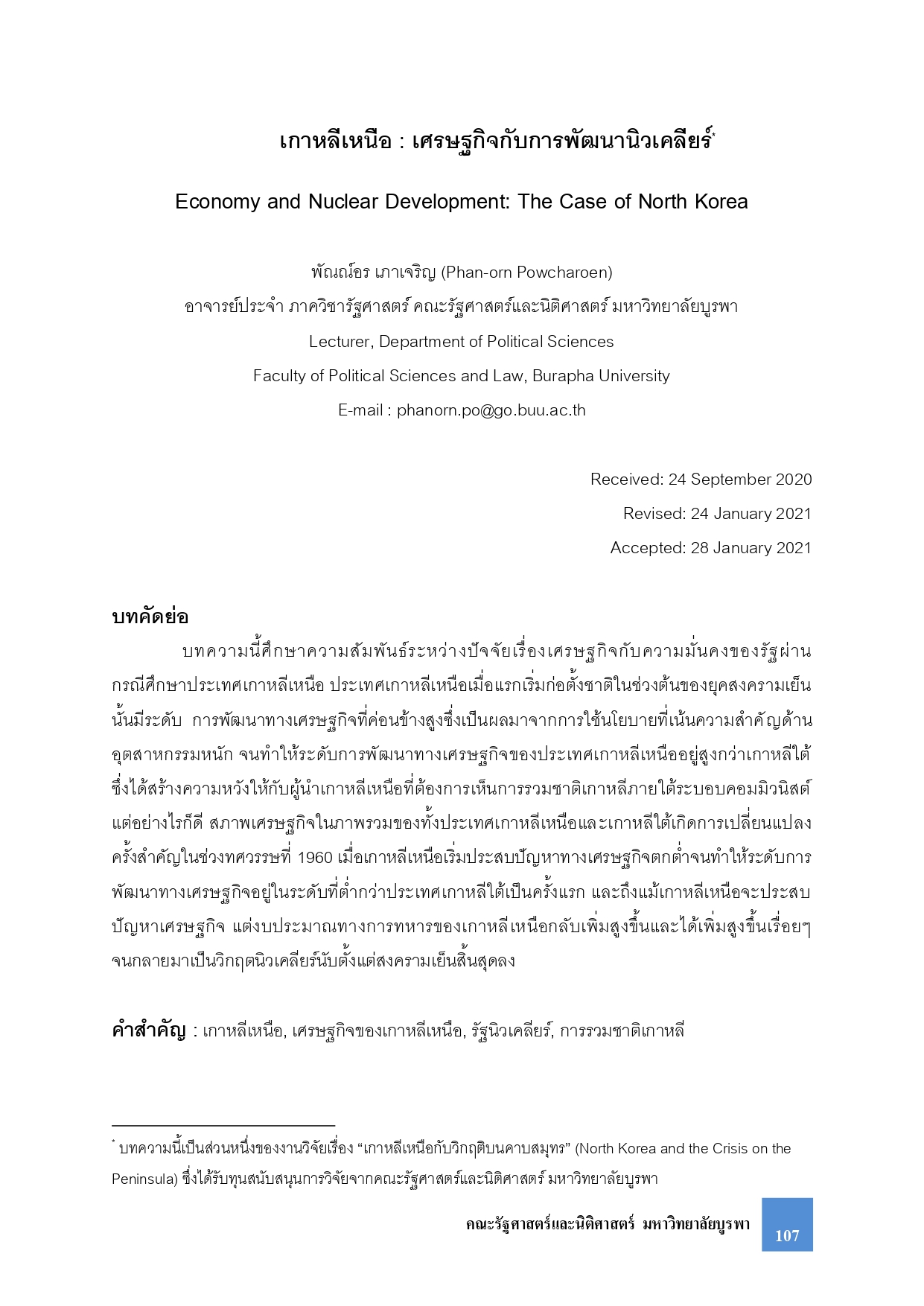Economy and Nuclear Development: The Case of North Korea
Keywords:
North Korea, North Korea economy, Nuclear Weapons State, Reunification of KoreaAbstract
This article studies the relations between economic development and state security of North Korea. In the early stage of the Cold War period, North Korea has a high level of economic development through the implementation of economic policy specifically focusing on heavy industry development. North Korea’s economic level far exceeds those of South Korea’s that it gives a full hope to the North Korean leader to realize the unification of Korea under its own terms. However, the situation begins to reverse in the 1960s when North Korea faces with economic difficulty that the overall level of economic development falls behind those of South Korea’s for the first time. Despite economic hardship, it turns out that North Korea pushes ahead with its military development. Military capabilities development of North Korea become higher as time passes that reaches to the point of nuclear crisis as soon as the Cold War has ended.
References
Alagappa, M. (2008). The Long Shadow: Nuclear Weapons and Security in 21st Century Asia.
California: Standford University Press.
Bae, J. (2003). Country survey XVIII: The two Koreas' defence economy. Defence and Peace
Economics, 14(1), 61-83.
Bae, J. (2004). An Empirical Analysis of the Arms Race between South and North Korea.
Defence and Peace Economics, 15(4), 379–392.
Brown, W. (2018). Special Report: North Korea’s Shackle Economy. The National Committee on
North Korea. Retrieved March 19, 2020, from https://www.ncnk.org/resources/briefing-
papers/all-briefing-papers/special-report-north-koreas-shackled-economy-2018
Cha, V. (2012). The Impossible State: North Korea, Past and Future. London: The Bodley Head.
Chung, J. S. H. (1972). North Korea’s “Seven-Year Plan” (1961-1970): Economic Performance
and Reform. Asian Survey, 12(6), 527-545.
Cho, M., & Zang, H. (1999). The Present and Future Prospect of the North Korean Economy. In Newsletter No. 14 September 1999. Asian Historical Statistics Project, Institute of
Economic Research, Hitotsubashi University. Retrieved September 5, 2020, from http://www.ier.hit-u.ac.jp/COE/English/Newsletter/index.html
Federation of American Scientists. (2000). Weapons of Mass Destruction. Federation of
American Scientists. Retrieved March 19, 2020, from https://fas.org/nuke/ guide/dprk/doctrine/
Goto, F. (1990). Estimates of the North Korean Gross Domestic Product, 1956-1959. Kyoto:
Kyoto Sangyo University Press.
Habib, B. (2011). North Korea’s Nuclear Weapons Programme and the Maintenance of the
Songun System. The Pacific Review, 24(1), 43-64.
Haggard, S., & Noland, M. (2017). Hard Target: Sanctions, Inducements, and the Case of
North Korea. Stanford: Stanford University Press.
Hamm, T. K. (1999). Arming the Two Koreas: State, Capital and Military Power. London:
Routledge.
Hayes, P., & Cavazos, R. (2014). “Kim Jong-Un’s “Fresh Leap Forward” 2014 New Year
Speech”, NAPSNet Special Reports. 1 January 2014. Retrieved September 5, 2020, from https://nautilus.org/napsnet/napsnet-special-reports/kim-jong-uns-fresh-leap-forward-2014-new-year-speech/
Hong, Y. (2004). North Korea in the 1950s: The Post-Korean War Policies and their Implications.
The Korean Journal of International Relations, 44(5), 215-234.
Jeon, M. (2009). The Kim Jong-il Regime's "Military-First Politics": Structure and Strategy of
Discourse. The Review of Korean Studies, 12(4), 181-204.
Lee, C. (1965). Stalinism in the East: Communism in North Korea in Robert A. Scalapino (ed.).
The Communist Revolution in Asia: Tactics, Goals and Achievements. Angled Cliffs:
Prince Hall.
Lee, J. (2016). The Republic of Korea’s Economic Growth and Catch-Up: Implications for the
People’s Republic of China. ADBI Working Paper Series. Asian Development Bank
Institute. Retrieved March 19, 2020, from https://www.adb.org/sites/default/files/ publication/183353/adbi-wp571.pdf
Lee, P. (1972). An Estimate of North Korea’s National Income. Asian Survey, 12(6), 518-526.
Lee, S. (1965). Stalinism in the East: Communism in North Korea. In Scalapino, S. (ed.) The
Communist Revolution in Asia: Tactics, Goals, and Achievements (pp. 114-139).
Englewood Cliffs, N.J., Prentice-Hall Inc.
Moon, C., & Lee, S. (2009). Military Spending and the Arms Race on the Korean Peninsula.
Asian Perspective, 33(4), 69-99.
National Museum of Korean Contemporary History. (n.d.). Export-Led Industrialization in Korea. Education Materials Series. Retrieved March 19, 2020, from
https://www.much.go.kr/en/contents.do?fid=03&cid=03_7
North Korea Economy Watch. (1999). Gross Domestic Product of North Korea 1999. Retrieved January 9, 2020, from https://www.nkeconwatch.com/nk-uploads/DPRK-GDP-1999.pdf
North Korea Economy Watch. (2011). Retrieved September 5, 2020, from
https://web.archive.org/web/20130726191655/http://intellectualtakeout.org/library/char
t-graph/institutions-matter-real-capita-gdp-north-and-south-korea
Nuclear Threat Initiative. (2011). North Korea Nuclear Chronology. James Martin Center for Nonproliferation Studies at the Monterey Institute of International Studies. Retrieved January 9, 2020, from https://media.nti.org/pdfs/north_korea_nuclear.pdf
O’Connor, T. (2020). South Korea Wants Peace, Less Certain about Unification 70 Years after
War. Newsweek. Retrieved June 25, 2020, from https://www.newsweek.com/south-
korea-peace-uncertain-unification-war-1513480
Park, Y. (2014). South and North Korea’s Views on the Unification of the Korean Peninsula and
Inter-Korean Relations. The 2nd KRIS-Brookings Joint Conference on “Security and
Diplomatic Cooperation between ROK and US for the Unification of the Korean
Peninsula. Retrieved June 25 2020, from https://www.brookings.edu/wp-content/
uploads/2014/04/park-young-ho-paper.pdf
Pinkston, D. (2006). North Korea’s Foreign Policy towards the United States. Strategic Insights,
(7), 1-7.
Selected Works of Kim Il Sung. (1971). Pyongyang: Foreign Language Publishing House.
Snyder, S. (2013). The Economic Costs of North Korean Nuclear Development. Retrieved
September 5, 2020, from https://www.cfr.org/blog/economic-costs-north-korean-
nuclear-development
Yonhaps News Agency. (2020). N. Korea ranks No.1 in military spending as percentage of
GDP. Retrieved January 9, 2020, from https://en.yna.co.kr/view/ AEN20200109007500325






